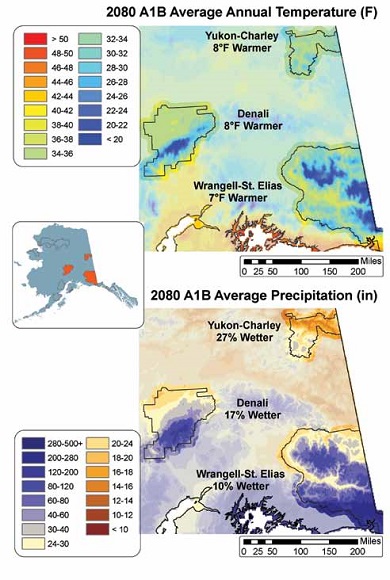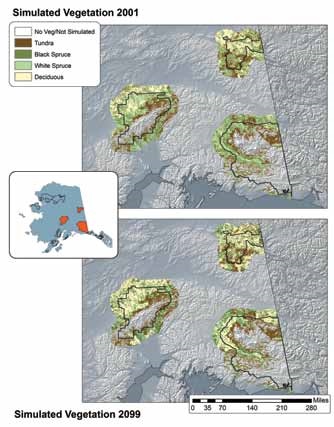
Introduction
The arctic and boreal ecosystems that dominate Alaska’s landscape are undergoing changes in response to rising temperatures and changes in precipitation regimes (Hinzman et al. 2005). Alaska has seen a warming trend over the past several decades, with an average increase in mean annual temperature of 3.4ºF/1.9ºC since 1950, and lengthening of the growing season (Karl et al. 2009). Some of this temperature increase is correlated to a 1976 phase shift of the Pacific Decadal Oscillation (Shulski and Wendler 2007), and General Circulation Models (GCMs) attribute additional warming to the increase in green-house gases (IPCC 2007). Since climate is a major driver for many ecological and biophysical processes, climate change is expected to have substantial impacts on fire-adapted northern ecosystems (Duffy et al. 2005). Fire in the boreal forests of Alaska already appears to be increas-ing in frequency, size and severity (Kasischke et al. 2010).
Climate change presents a significant challenge to managing our natural and cultural resources. Ecological models that project effects of climate change on plants, animals, and other system components can be used by managers to understand how these effects will impact park resources. For example, the Boreal ALFRESCO model provides a tool to simulate future fire regimes and changes to vegetation under different climate scenarios. We utilized this model and future climate predictions from several GCMs to explore the potential changes in fire regime and vegetation composition for three parks. The interior Alaska parks selected have significant acreages of boreal forest: Denali National Park and Preserve, Yukon-Charley Rivers National Preserve, and Wrangell-St. Elias National Park and Preserve.

Methods
The boreal forest version of ALFRESCO was developed to explore feedbacks and interactions between fire, climate, and vegetation in interior Alaska (Rupp et al. 2007, Duffy et al. 2007) as well as associated impacts to natural resources (Rupp et al. 2006, Butler et al. 2007). ALFRESCO does not predict fire behavior, but rather provides future fire regime and extent scenarios, including estimates of annual area burned and fire return intervals. These estimates are based on an empirical relationship between monthly temperature and precipitation, and total annual area burned. ALFRESCO also simulates changes in vegetation flammability associated with the successional shifts from deciduous to needleleaf forests, as well as between tundra stages.
ALFRESCO begins with a vegetation map that includes the aforementioned vegetation types and estimated time since the last fire. Fires simulated by the model are ignited randomly and are driven by climate and vegetation type (Rupp et al. 2007). The fire can then spread to adjacent vegetation as a function of vegetation flammability and natural firebreak effects (e.g. non-vegetated mountain slopes and large water bodies).
GCMs are the most widely used tools for projec-tions of global climate change over the next century. For this study, climate projections were based on five climate models from the IPCC Fourth Assessment (2007) deemed to best perform in Alaska (Walsh et al. 2008): Echam5, Gfdl2.1, Miroc3.2MR, HadCM3, and CGCM3.1. The models were run with a greenhouse gas scenario (A1B) that assumes emissions will increase through mid-century and then decline as lower carbon-emitting energy sources are developed.

Results
Future climate scenarios
Based on a composite of the five best-performing GCMs, temperatures in interior Alaska’s national parks are projected to increase over the coming decades at an average rate of about 1°F (0.56°C) per decade. Average annual temperature is expected to rise by about 5°F (2.8°C) by 2040 and as much as 8°F (4.4°C) by 2080 (Figure 1). This would result in a transition from average annual temperatures below the freezing point (<25°F/-3.9°C) to temperatures near or above the freezing point (>32°F/0°C). Average annual rainfall is expected to increase by 10 to 27%, however it is uncertain whether this will be enough to offset an increase in evapotranspiration caused by warmer temperatures and a longer growing season.
Acreage Burned Annually
We used Boreal ALFRESCO to simulate future fire activity under different climate scenarios from the best performing GCMs, and present one that best represented recent fire history. Based on simulation results from the composite scenario (Figure 2), the model suggests that Yukon-Charley would likely experience more frequent large fire seasons over the course of the next century, with several fire seasons approaching and/or exceeding 250,000 acres. Modeled fire patterns in Denali identify the potential for very large fire seasons (>1,500,000 acres) in the near future, which may result in a less flammable landscape for several decades following, and then the eventual return of large fire seasons (~250,000-700,000 acres) occurring more frequently. The simulation results also suggest that Wrangell-St. Elias would likely experience large fire seasons at decadal intervals.

Fire Return Inverval
The ALFRESCO model does not provide a direct prediction of where a fire will occur. It does, however, convey the likelihood of fire activity based on the flam-mability of the vegetation and climatic conditions. By analyzing many replicate simulations, maps can be made of where fire activity is most likely to occur. The number of times an area burns can be divided by the number of simulations (200 for this study), and the number of years (100 yrs) to create a fire risk map for that time frame – i.e., the probability of an area burning in any one year. The inverse of that probability is the fire return interval.
ALFRESCO simulation results predict that much of Yukon-Charley, the northwestern section of Denali, and areas along the Copper River on the western edge of Wrangell-St. Elias will experience fire return intervals of less than 100 years. Therefore these areas may burn more than once in the next century (Figure 3). These regions are dominated by spruce forests (Figure 4) and the climate will be warmer and drier than other areas within the parks (Figure 1). Regions currently dominated by deciduous vegetation or with slightly more moderate climates are likely to burn at least once in the next century, and thus may experience fire return intervals closer to 200 years.
Vegetation Change Simulations
The simulated response of vegetation to increased burning suggests the potential for a substantial shift in the future proportion of conifer and deciduous forest on the landscape (Figures 4-5). Acreages for each forest type were summed for all three interior national parks for intervals across the coming century. Acreage of white spruce forests are predicted to decline by approximately 30% as a result of fire, while black spruce forests are predicted to decline by nearly 15%. As spruce forest burns across the interior, they are assumed to be replaced by early successional deciduous forest, which is estimated to increase in area by 45%.

Summary of Preliminary Simulation Results and Management Implications
Temperatures across most of Alaska’s national parks are projected by climate models to increase by approximately 1°F (0.56°C) per decade. For parks within the fire-prone interior region of the state, this warming would result in a transition from annual temperatures averaging below freezing (<32°F/0°C) to temperatures substantially above this biologically important threshold. The largest temperature increases are predicted to occur in winter, increasing on average by 10°F (5.6°C) or more. This could increase the length of the growing season and, therefore, the fire season. Precipitation projections suggest an increase of about 20% in summer for interior Alaska, although conditions could become drier due to warmer temperatures resulting in greater evapotranspiration. Drier conditions during any part of the summer could result in further increases in fire activity and severity.
The ALFRESCO model simulations for Alaska’s parks suggest a general increase in fire activity through the end of this century (2099) in response to projected warming temperatures. Examination of the projected cumulative area burned suggests the next 20-30 years will experience the most rapid change within the next century in both fire activity and associated changes in vegetation dynamics. Future fire activity suggests more frequent large fire seasons and a decrease in magnitude of, and time between, small fire seasons.
The predicted increase in fire activity strongly suggests that boreal forest vegetation will shift from spruce-dominated forest, prevalent across the landscape during the last century, to deciduous dominated forest.
These forests will be younger due to more frequent fires, and older forests would decrease across the landscape (Duffy et al. 2005). This change could occur over the next few decades if changes in climate lead to increased fire activity. In fact, such a change may already be occurring, with the recent occurrence of multiple large fire seasons across interior Alaska (Duffy et al. 2005). If fire frequency as well as fire severity continue to increase, early successional deciduous and spruce forests could self-perpetuate for many decades if not centuries. Additionally, because there would be more frequent burning, there would be an overall increase in annual acres burned.
Because climate is an important driver of fire, GCMs that predict warmer temperatures produce different results than those that predict less warming. In this study we have evaluated the results of combining five models; however, by running ALFRESCO using the results of individual models we would get a broad range of future fire regime predictions. Our results suggest a shift in dominance from conifer to deciduous vegetation within the next 50 years. However, it is important that the range of predictions be considered when making land and resource management decisions.
Decisions made by fire and land managers during this current period of climatic change will influence the structure and pattern of vegetation across the boreal forest in Alaska. The boreal ALFRESCO model can be used to simulate how climatically driven changes in the fire regime and corresponding management may change the potential future landscape. This includes the charac-terization of how particular vegetation of a particular age class that may represent habitat conditions for important wildlife resources may be affected by the fire, vegetation and climate interactions predicted into the future. Thus, ALFRESCO can used to guide monitoring and research to better understand how fire regimes are changing, which will be critical towards achieving management objectives.
Acknowledgements
This work is supported by grants from the National Science Foundation and the Joint Fire Science Program. Additional support has been provided by the U.A. Scenarios Network for Alaska Planning (SNAP) program and from the University of Alaska Fairbanks, U.S. Fish and Wildlife Service, The Wilderness Society and the National Park Service.
References
Last updated: October 23, 2021
